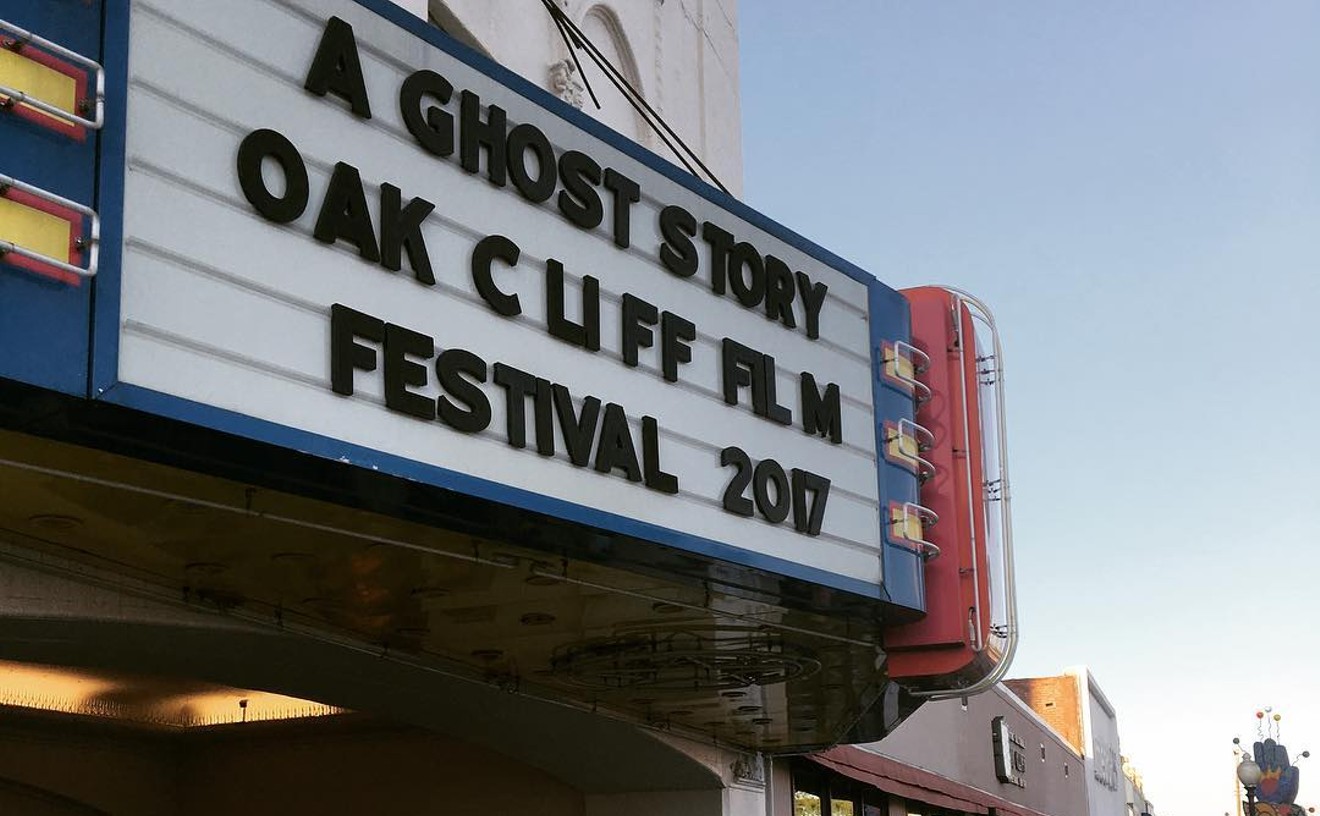South of Interstate 30 is an area that most Dallasites associate with one thing, lofts: those curSrently hip, so-called urban, overpriced living spaces that commercial real estate developers are banking on as the yupscale future. But this still-developing area, a mix of older industrial buildings and houses where lower-income families reside less than a quarter of a mile from top-of-the-line SUVs barricaded behind security gates, is the perfect environment for two of Dallas' most offbeat galleries. Plush and Purple Orchid are housed in one of those older industrial expanses, and both take a clever, tongue-in-cheek approach to skewering the hoity-toity attitudes of the contemporary art world by exploring a less academic version of conceptual art.
Plush gallery director Randall Garrett's biggest asset is his seemingly ceaseless energy and enthusiasm. This constantly busy curator and artist seems like he could whip up a show in a compact car in two days if he wanted to, even if that manic verve results in a show that looks like that's just what happened. Plush's current show, Perpetually Abuzz in a Land of Hyped-up Frenzy, couldn't be more appropriately named. It's the best expression for Plush's overall reason to be. The nine-person show is somewhat schizophrenic, though it does provide a fair representation of what Plush's edgy exhibitions have been up to as the gallery commemorates its first anniversary.
The artists gathered, Garrett, Marcia Alaniz, Dwayne Carter, Zach Eichelberger, April Holland, Teresa O'Connor, Patience Rose, Jesse Meraz and Michael Wynne, really don't have anything unifying their work other than the fact that they use a variety of unorthodox media to create fashionably nonobjective, nonrepresentational pieces. Of course, saying that is like pointing out that humans are biologically related to pigeons and trout because all three have a digestive system of some sort. It's true, but it's also misleading.
This lack of any subject matter or thematic organization makes Abuzz feel a little shallow. It's a shortcoming that's not aided by works that employ purposely naïve irony, such as O'Connor's fabric piece "Puff," Rose's mixed-media "Bunny Love" and Alaniz's oil-on-canvas "The Hat." These pieces feel like they're trying too hard to be slyer than they are. Next to them, the somewhat more effective works, such as Meraz's glitter sculpture "Luxe," Wynne's fabric roll "Lead Me On" and Garrett's bathroom installation "Red Zone," feel more compelling, even if it's only by comparison. But there are hints of what may have been the goal of Frenzy: "Lead Me On"'s roll of silk-screened fabric and Garrett's discofied bathroom both take jabs at mundane materials and settings being made to appear more hip through very minor and mediocre decoration. It's enough to make you suspect that Frenzy wanted to be a wry encapsulation of the artists' youthful glee in reacting against the plasticity of commercial, middle-class America.
Portions of Purple Orchid's Paris, Texas are more satisfying, though it's also a concept-organized show that aims for a higher plane than it achieves. Organized by Purple Orchid director Joe Allen and French artist Guillaume Paris, Paris brings together three American and three French artists who all use a similar vocabulary, one that explores conceptual objectives with contemporary materials and objects.
Fort Worth artist Helen Altman's "Seed Skulls" is the real oddity in this batch. Consisting of six rows of six skulls fashioned out of seeds and mounted against a yellow background, it feels almost primitive next to the show's video installations and high-concept pieces, and definitely out of place.
A better indication of the show's temperament is found in Allen's three-monitor video installation "Before Hagia, After Hendrix" and single-monitor video piece "Pipeline." Both use looped, computer-generated imagery--"Hendrix" a three-part kaleidoscope of color, and "Pipeline" a swirling vortex--that takes a pop approach to 1960s psychedelia using digital means. But it's an enterprise that reads more self-reflective than anything else: They're video documents of digital experiments.
Paris' two works are just as self-conscious. "White Magic" uses soap flakes to spell out the two words of the old soap brand name on the floor of the gallery. And Paris' video piece "Minding" is a continuous loop of what appears to be the animated owl from Bambi walking around in a circle, his eyes always remaining locked on whoever is watching the screen. It's slightly creepy at first but little more than that.
San Antonio artist Hills Snyder takes the America-meets-France idea a bit more explicitly with his "Double Lunette," a wall-mounted, acrylic-on-board, side-by-side pair of guillotines. Think of it as the his and hers approach to beheading. It's funny, but Snyder's odd melding of ideas--a very contemporary interpretation of an icon of the French Revolution--was better served in his solo show at the Angstrom Gallery last month. There, he explored his contemporary vision of the past in a number of pieces, and they all combined to give the work a resonant edge that "Double Lunette" lacks. Without a more developed context, Snyder's mischievous sense of humor doesn't take you anywhere after funny.
The wit of Patrick Lebret's "Pollock knit for you" succeeds where Snyder leaves you hanging. This floor-mounted tangle of different-colored threads and yarn creates a large, square pile that looks very much like one of Pollock's action paintings of the late 1940s. But by installing the layered cobweb of thread on the ground, he emphasizes gravity's role in Pollock's process. For some reason, looking at Pollock-type imagery on the ground rather than the wall doesn't make Pollock's drip technique seem all that impressive.
The two standout works in the show are studies in extremes. Allen's small video installation "I Like the Nightlife" projects an image of Caravaggio's "The Crucifixion of St. Peter" onto a row of cigarettes in a cigarette case. It's very simple, but it allows Allen to make a complex joke about stereotypical French popular culture. He combines the Old World traditions symbolized by the Baroque master's painting with the continental charms of cigarettes stylishly stashed in a cigarette case and brings them all together under a title borrowed from a disco song. It reminds you that despite France's superior attitudes, what the country chooses to embrace from American popular culture, be it dated and trite popular music or Jerry Lewis, is decidedly lowbrow.
Likewise, Stéphane Magnin's large-scale "MXY7 Suicide Rocket pour Altaïr-nécroculture-complex" is an equally clever comment on America. For this multimedia piece, entire balls of thread are pinned to the wall at specific vertices. They form a line drawing of a spaceship--a staple image of the science-fiction genre. While French author Jules Verne can be considered the father of science fiction, it was America that turned Verne's literary imaginations into the stuff of popular serials such as Flash Gordon and Star Wars. Magnin accents America's footloose, juvenile appreciation for simple entertainment with three items that lean against the wall beneath his spaceship: a toy bowling set, a Goofy beach ball and AC/DC's album For Those About to Rock, We Salute You. (The album is an exceptionally pithy French flourish: What better way to poke fun at the gauche United States than by singling out a hard-rock outfit familiar to virtually all red-blooded Americans--people whom the French stereotypically deride even more than the British. Plus, it's a group that hails from a land that was once England's prison.)
That mischievous comic sense camouflaging a lofty concept seems to be the sort of high-meets-lowbrow art that these two exhibitions want to promote, highlighting works that are both intelligent and accessible to viewers across town or the Atlantic. It's the sort of approach that artists in Los Angeles and San Francisco pioneered in the 1960s and has become the au courant flavor of Las Vegas more recently, but it's slightly tweaked by the artists here. Paris and Frenzy don't entirely succeed in breaking new ground, but it's refreshing to encounter such energy even when it's applied to an effort that falls short of such an enticing goal.










